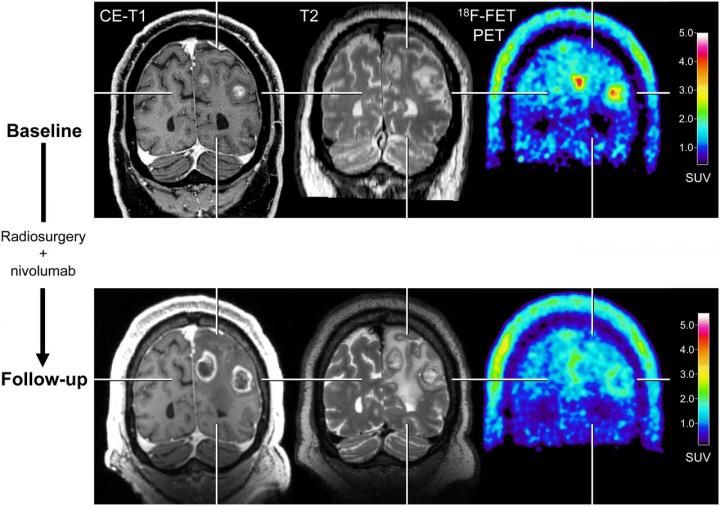PET Imaging Identifies Efficacy of New Brain Metastasis Treatments
Adding 18F-FET PET to contrast-enhanced MRI can better determine which patients are responding well to immune checkpoint inhibitors or targeted therapies.
Adding amino acid PET to contrast-enhanced MRI imaging can help radiologists better determine whether a patient has suffered a recurrence of a brain metastasis and how well he or she is responding to treatment.
Although new treatments for brain metastases, such as immune checkpoint inhibitors (ICI) and targeted therapies (TT), are effective, assessing just how well they are working in an individual patient can be difficult. The results produced by contrast-enhanced MRI can be variable, said a team of German investigators.
Consequently, there is a need for new assessment strategy, they said.
“Essentially, these new treatments have requirements of brain imaging which cannot be met by conventional MRI,” said Norbert Galldiks, M.D., a neurology professor, as well as a neurologist and neuro-oncologist at the University Hospital Cologne and Research Center in Juelich, Germany. “In our study, we tried to determine if adding 18F-FET PET could help to overcome some of these imaging challenges.”
Galldiks’ team published their findings recently in the Journal of Nuclear Medicine.
Related Content: PET/MRI Outperforms PET/CT in Cancer Imaging
For their retrospective study, the team enrolled 40 patients who had 107 brain metastases that were secondary to melanoma and small cell lung cancer. These individuals were treated with either ICI or TT alone or in combination with radiotherapy.
After radiosurgery concurrent with nivolumab in 59-year-old patient with melanoma BM (patient 1; Supplemental Tables 3 and 5), F-18 FET PET at follow-up 12 weeks after treatment initiation (bottom row) shows significant decrease of metabolic activity (TBRmean, ?28%) compared with baseline (top row), although MRI changes were consistent with progression according to iRANO criteria. Reduction of metabolic activity was associated with stable clinical course over 10 mo. CE = contrast-enhanced.
CREDIT: N. Galldiks et al., Research Center Juelich, Juelich, Germany.

Overall, the team conducted 60 18F-FET PET scans to monitor their treatment efficacy between 2015 and 2019. In 27 patients, it was used to differentiate treatment-related changes from metastasis relapse after ICI or TT, and in 13 patients, it was performed for response assessment to both treatments, using baseline and follow-up scans.
Based on their analysis, the team determined that 18F-FET PET can correctly diagnose brain metastasis relapse and pinpoint which patients are responding to treatment and which are not. Specifically, they found a tumor-to-brain ratio threshold of 1.95 differentiated brain metastasis relapse from treatment-related changes with 85-percent accuracy. In addition, they saw that metabolic responders to ICI or TT on 18F-FET PET had significantly longer stable follow-up, and their time to peak also increased substantially, as well.
Ultimately, Galldiks said, using 18F-FET PET is beneficial in monitoring ICI- or TT-treated patients.
“In cases of ambiguous MRI findings, supplemental FET PET is helpful for treatment monitoring. It provides physicians with a longer time window for subsequent patient management and allows them to optimize the treatment strategy for each individual patient,” he said. “Since this approach is so accurate, it has the potential to influence clinical decision making. This may help to reduce the number of invasive procedures and limit over-treatment for a considerable number of seriously ill patients with brain metastases."
For more coverage based on industry expert insights and research, subscribe to the Diagnostic Imaging e-Newsletter here.
Emerging AI Algorithm Shows Promise for Abbreviated Breast MRI in Multicenter Study
April 25th 2025An artificial intelligence algorithm for dynamic contrast-enhanced breast MRI offered a 93.9 percent AUC for breast cancer detection, and a 92.3 percent sensitivity in BI-RADS 3 cases, according to new research presented at the Society for Breast Imaging (SBI) conference.
Could AI-Powered Abbreviated MRI Reinvent Detection for Structural Abnormalities of the Knee?
April 24th 2025Employing deep learning image reconstruction, parallel imaging and multi-slice acceleration in a sub-five-minute 3T knee MRI, researchers noted 100 percent sensitivity and 99 percent specificity for anterior cruciate ligament (ACL) tears.
New bpMRI Study Suggests AI Offers Comparable Results to Radiologists for PCa Detection
April 15th 2025Demonstrating no significant difference with radiologist detection of clinically significant prostate cancer (csPCa), a biparametric MRI-based AI model provided an 88.4 percent sensitivity rate in a recent study.